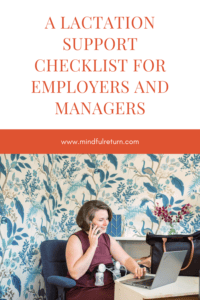 “We want to provide our employees with lactation support,” I hear from employers. “We want to do the right thing.” But the devil is always in the details, right? Wanting to be helpful and knowing specifically what to do are two different things.
“We want to provide our employees with lactation support,” I hear from employers. “We want to do the right thing.” But the devil is always in the details, right? Wanting to be helpful and knowing specifically what to do are two different things.
If you’re an employer who wants to do right by your new parent employees, see how many of the things on the list below you’re already doing. Can you add one or two other supports to what you currently offer?
And if you’re a new parent who is pumping, I’m excited to share with you today a checklist you can hand to your employer and/or manager. If they take the steps below, they will absolutely make your working parent pumping journey a smoother one.
The lactation support checklist below was created by a working, pumping mama of two little girls. Masha Sapper is today’s guest on the Mindful Return blog. She was inspired by her own challenging pumping experience to want to help other new parents not share her struggles. (Masha is also returning to the Mindful Return for a second time – check out her earlier blog post here: Single Moms By Choice: An Interview with an SMBC Working Mama.)
Thank you, Masha, for creating this amazing resource, and for sharing it with the Mindful Return community!
************************************
When I returned to work after my two parental leaves, by far the biggest issue I had in adjusting to my new role each time was how to manage pumping. After the birth of my first child, I was working in several different locations all around the DC and Baltimore areas. None of these locations had dedicated pumping spaces. What’s more, no one had put any thought into where I would be able to pump when I was there.
It was a daily challenge to find a space where I could pump. One day, I was told I could pump in the copy room. I then realized that the copy room didn’t have a lock. So I told everyone in the office that I would be pumping there. I even made a sign for the door. And still, a colleague walked in on me. After that, I bought a doorstop and kept it in my pumping bag.

Another time, I asked the location manager to reserve one of the on-site meeting rooms for me. They did, but the small room had a big window in the door. There was nowhere in the room that was out of the line of site of the window. I managed to find a piece of cardboard and a poster in the recycling bin. I taped them to the window and used my shirt to block the rest. Here’s a picture of my super sophisticated solution!
Over the months that I pumped, I begged colleagues for use of their private offices. Pumped while shirtless and driving 65 miles an hour on I-95. Woke up at 2:00am each night to pump just a little more milk. And generally spent most of my working life worrying about whether I’d be able to produce enough milk for my daughter for the next day.
Fortunately, with the recent passage of the PUMP Act, there are now more protections for new parents in the workplace who are pumping milk for a new baby. Federal law requires that employers with more than 50 employees provide a reasonable amount of break time and a space to express milk as frequently as needed for the first two years after the baby’s birth.

A Lactation Support Checklist for Employers
Since this was such a struggle for me, I wanted to create a pumping checklist that lactating parents could share with their employers, supervisors, and co-workers. The goal of this lactation support checklist is to educate them about how to accommodate and support pumping parents in the workplace.
Please share this with anyone who can use this tool!
For anyone who is considering where someone will pump, let’s start with this: under the legal requirements, what makes an acceptable pumping space?
- The space must be private. This means it must be shielded from view and free from any intrusion from co-workers and the public.
- The location provided must be functional as a space for expressing milk.
- If the space is not dedicated to the pumping employee’s use, to meet the statutory requirement, it must be available whenever the employee needs it.
- The space may not be a bathroom.
- The space must be close to the employee’s workspace.
What does this mean, exactly?
- The space must be clean and sanitary. You should deep clean the space before the employee starts using it. Also make sure it receives regular cleaning on the same schedule as all other office spaces.
- To be functional for pumping, the space should have at least one power outlet, so the employee can power their pump. It should also have a chair for the employee to sit in and a table for them to put their pump and supplies on.
- Because the space must be private, if it has any glass walls or windows, they need to have coverings that are sufficient to shield the employee from view. Additionally, the space must not be under video surveillance.
- The space must be free from intrusion from co-workers and the public. You need to make sure the door can be locked by the employee, provide a door stop for the employee to use to secure the door, and/or provide a sign to display when the pumping space is in use.
- If the employee is teleworking, they are still entitled to breaks for pumping. You cannot require them to be on camera, if they are attending an online meeting while pumping.
- You should also familiarize yourself with any state or local laws on this subject, as they may have additional requirements or protections.
If you’re an employer with little office space and are not required by law to have a pumping space available at all times, how can you make sure you have a space ready for an employee who needs it?
- Identify a space that can be used for pumping, before it’s actually needed. If there are other stakeholders, be sure they are consulted and agree with the space selection.
- Purchase and store the supplies needed in advance.
- Talk to your team members when they notify you that they will be taking parental leave. Ask if they anticipate needing a pumping space upon their return.
- Remember that non-gestational parents sometimes choose to induce lactation. Do not limit your outreach to gestational parents only.
- Ask if you can check in with a new parent during their leave, to confirm that their plans for pumping have not changed. If they agree, discuss how and when they prefer to be contacted.
- Be sensitive during any check in. If an employee’s feeding plans have changed unexpectedly, they may be upset or disappointed about the change.
- Make sure the pumping space is ready for the new parent’s use when they return to work. Do not ask them to identify, set up, or prepare the space themselves.
Now, let’s talk about how to turn an acceptable pumping space into a great pumping space, and how to provide amazing support to your new parent colleague.
Note: Pumping can be both difficult and uncomfortable. Your efforts to make the experience as comfortable as possible for your team member will be greatly appreciated!
- Make sure the seating is comfortable.
- Provide reliable internet access in the space. This is especially important if the employee can do their work from a computer and wishes to work while pumping.
- Provide additional power outlets or a power strip.
- Provide a refrigerator for storing pumped milk.
- Provide a sink, sponge, dishwashing detergent, towels, and a drying rack to wash and dry pump parts.
- Provide a microwave, to allow employees to use microwavable sterilization bags for their pump parts.
- Provide snacks and water. Milk production is better when the team member isn’t thirsty or hungry.
- Provide a thermostat for the space that the employee can control. A room that is too cold or too warm can negatively impact milk production.
- Provide a sound machine to minimize the extent to which the sound of the pump can be heard on calls or from nearby spaces.
- Decorate the space in a way that is appealing and makes it a space that people will enjoy spending time in.
What are some other ways that I can support my team members who are pumping milk for their baby?
- Ask them to block off the time on their calendar or send you a calendar invitation for their pumping times. That way, you won’t accidentally schedule meetings or events during these times.
- Ask them if they would appreciate having you proactively protecting their pumping times. For example, in a meeting that is running long, would they like you to remind the group that this team member has a “hard stop?”
- If you are organizing appreciation efforts for the team, be sure that they still get to enjoy them. For example, if you are ordering snacks or lunch which will arrive while they are pumping, ask them if you can set some aside for them.
- If they will be attending any work functions off-site, such as a conference or meeting, make sure that those venues have appropriate pumping spaces.
- If they will be traveling overnight for work, offer to reimburse them for a milk-shipping service as a travel expense. Services like Milk Stork will ship their milk back home for their baby while they are on the road.
If you are an employer, thank you for reading this! Adjusting to work after the birth or adoption of a new child can be very difficult for new parents. Your efforts to be a supportive and impactful ally to these team members will make a significant difference to their experience working for you.
 Masha Sapper is a Vice President of Business Services. She provides software implementation, training, and support for a company managing on-campus student housing. Masha earned a BS in Mathematics and a BS in Math Secondary Education from the University of Maryland, College Park. She currently lives in Wheaton, Maryland with her eighteen-month-old and five-year-old daughters.
Masha Sapper is a Vice President of Business Services. She provides software implementation, training, and support for a company managing on-campus student housing. Masha earned a BS in Mathematics and a BS in Math Secondary Education from the University of Maryland, College Park. She currently lives in Wheaton, Maryland with her eighteen-month-old and five-year-old daughters.
Want more practical tips on working parenthood? Check out my book, Back to Work After Baby: How to Plan and Navigate a Mindful Return from Maternity Leave
Our Gift To You
At Mindful Return, we know that calm, thoughtful planning, and time for reflection, are keys to success in working parent life. Our FREE guide, 99 Questions to Ask Yourself Before, During, and After Parental Leave, is our gift to you and your new bundle of joy.
Success!
Join Our Weekly Newsletter
Looking for more support as a working parent? Our practical, tactical, and supportive Saturday Secrets newsletter will arrive in your inbox *every* Saturday morning, without fail.
Success!
The post A Lactation Support Checklist for Employers and Managers appeared first on Mindful Return.
